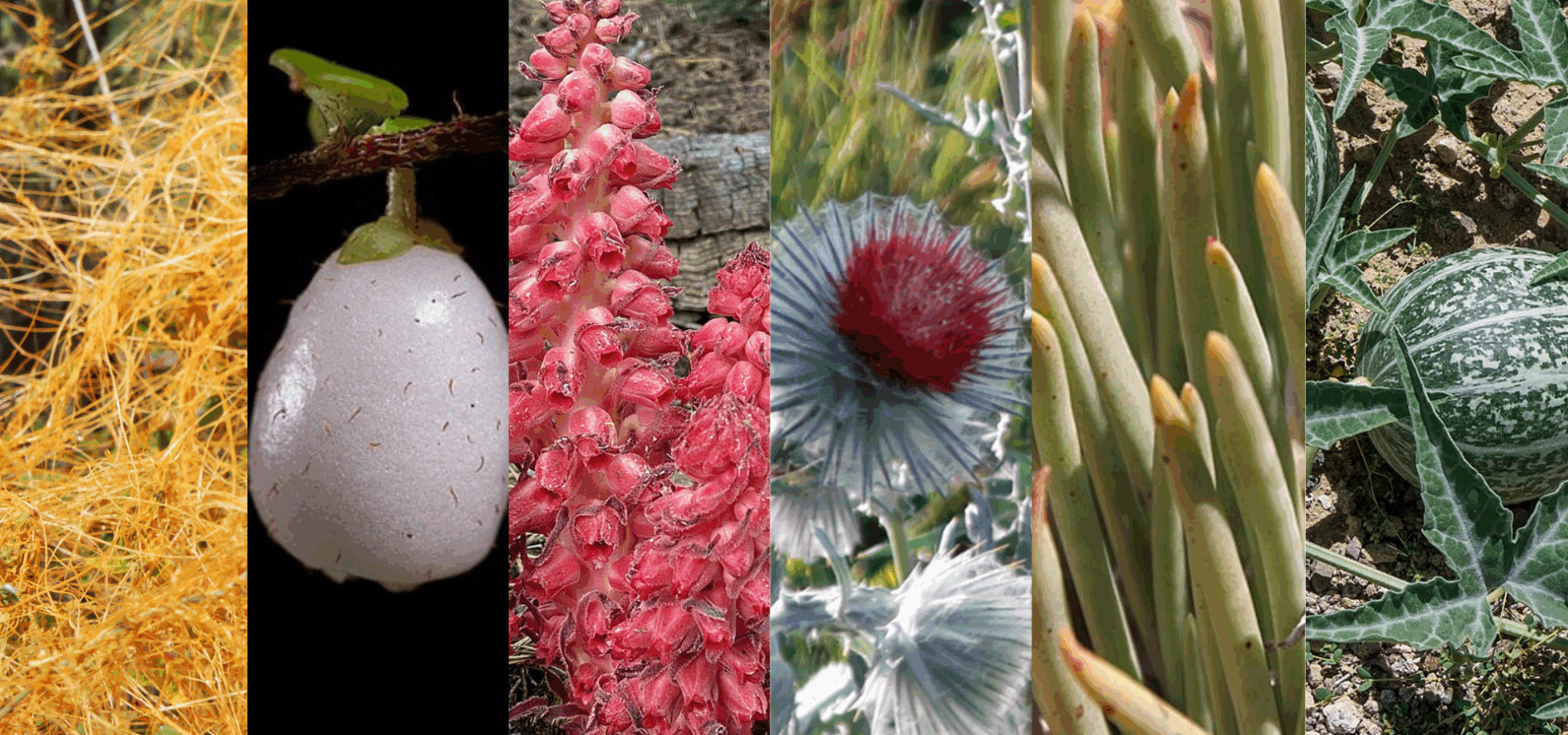Spooky season is here…step into our haunted native garden IF YOU DARE!
From a stem parasite that can “see” and “smell” its hosts to a charming but deadly flower, here are five of the creepiest native plants you can find growing around SoCal:

California dodder (Cuscuta californica)
Have you ever noticed a strange, orange, spaghetti-like substance creeping its way across a roadside field? Odds are you saw Cuscuta californica—or California dodder. This bizarre parasitic plant, which is sometimes referred to as “witch’s hair,” has the almost supernatural-seeming ability to “see” and “smell” the plants around it, by using phytochromes that detect light and sensing the chemical compounds the plants emit. Once it finds a suitable host like buckwheat or sage, the dodder penetrates the tissues of that plant to attain nutrients. Usually though, it doesn’t kill the plant—that would be counter-productive from an evolutionary standpoint.

Snow plant (Sarcodes sanguinea)
Sarcodes sanguinea is commonly referred to as the snow plant because of its tendency to pop up as ground thaws in late spring. But its scientific name–which roughly translates to “bloody flesh-like thing”–is probably a more apt description of its bizarre, meaty appearance. And its looks aren’t the only strange thing about it. Lacking in chlorophyll, this plant is unable to photosynthesize and doesn’t need sun to survive. Instead, it derives its nutrients from the mycelium that grow around the roots of conifer trees, which have a symbiotic relationship with the fungi. The snow plant taps into this mycorrhizal network, stealing away some of those sugars–making it an indirect parasite of conifers.

Death camas (Toxicoscordion venenosum)
If you ever find yourself foraging for wild onions, make sure you don’t accidentally pick a death camas instead. Though California’s native Toxicoscordion venenosum plant is related to lillies—and boasts similarly lovely white flowers—it is extremely toxic to both humans and animals. All parts of the plant can result in sickness or death, even when just a small quantity is consumed. Even the nectar is poisonous, and there is only one creature that has evolved to handle it—the Death camas miner bee, which is completely responsible for this plant’s pollination.

Cobweb thistle (Cirsium occidentale)
California has a handful of native thistle plants, but Cirsium occidentale is the spookiest by far. As its common name suggests, the vibrant magenta tuft at the top of this spiky plant is enrobed in strange, web-like threads. But while its intimidating spikes and blue green-grey coloring might give it a ghostly appearance, it’s actually far less scary than the invasive thistles that wreak havoc on our ecosystems. Well-adapted to our climate and abundant in nectar, it’s a favorite food source of many native birds and bugs, and a host plant to pollinators like the painted lady butterfly!

Coyote melons (Cucurbita palmata)
Come Halloween time, it’s common for people to decorate their stoops with Cucurbita pepo, the common field pumpkin. But did you know we have our own Cucurbita variety right here in SoCal? Cucurbita palmata, also known as coyote melons, are part of the squash family. But unlike their fleshy cousins, they thrive in dry, arid conditions. They are kind of like our own little desert pumpkins! Though we wouldn’t suggest carving or eating them (they are extremely bitter).
Runners up:
More spooky-sounding plants to add to your haunted native garden:
Fingertips (Dudleya edulis)
Western Spleenwort (Asplenium vespertinum)
Creeping snowberry (Gaultheria hispidula)
Datura aka “Devil’s Trumpet” (datura wrightii)
California mugwort (Artemisia douglasiana)
Bluewitch nightshade (Solanum umbelliferum)
Ghost Flower (Mohavea confertiflora)
Poison oak (Toxicodendron diversilobum)

